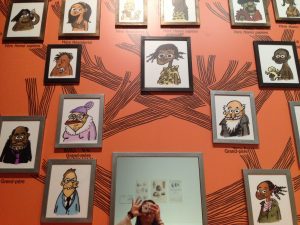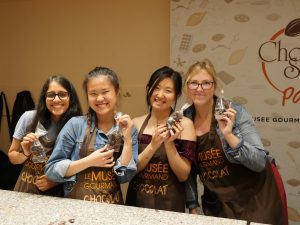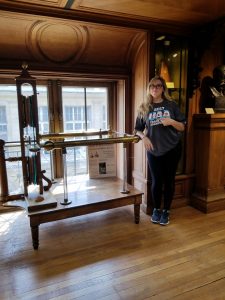Earlier this week, we took a class trip to Musée de l’Homme, which as your rudimentary French might suggest, specializes in all things human. This anthropological museum opened an exhibit just this past March titled, “Néandertal l’Expo,” and covers everything from general Neaderthal knowledge to lesser known facts and findings. Incorporating archeological findings, popular culture, and interactive displays, this exhibition comprehensively covers the misconceptions, controversies, and remaining mystery surrounding Neanderthal life and extinction, and is a must see for any Paris travelers with moderate to extreme interest in anthropological sciences. The rest of the museum includes everything from displays on evolution, human history, science of language, world cultures, gender issues, all the way to Lucy the 3 million-year-old Australopithecus and one of the most prominent fossil findings of all time.
The Dark and Dangerous History of Phrenology
On Wednesday, the halfway point of our program, we visited Musée de l’Homme, Paris’s anthropology museum. While we were there the temporary exhibit was le Grande Galerie de l’Évolution, or the Gallery of Evolution. We walked through the layout of your typical cave home, used interactive technology showing our genetic relationship with Neanderthals, and learned about the various instances in which cannibalism is acceptable in certain cultures.
After exploring this exhibit, we were able to wander around the museum on our own. Given the jam-packed nature of human history, you can imagine the breadth of artifacts and historical replicas on display throughout the museum. Topics ranged from the diversity of human language to “momie chachapoya” or an Incan mummy, to how genetics have shaped our evolution.

Continue reading “The Dark and Dangerous History of Phrenology”
Blog 3-Humans and Neanderthals: Are we really so different?

This Wednesday, after classes, we went to the Musée de l’Homme: the museum of man… This anthropology museum tells the story of the evolution of man and also focuses on the customs and material culture of different cultures. But we were in for a special treat, since the museum was hosting a Neanderthal exhibit. As Neuroscience students, that is most interesting to us, since it allows for a peak into the evolution of the human brain and culture and some speculation into the possible interactions modern humans and Neanderthals might have had. After all, we now have evidence of mating between the two species (Weaver & Roseman, 2005).

Continue reading “Blog 3-Humans and Neanderthals: Are we really so different?”
Calories or Cognitive Enhancers?
Our class kicked off the week by fulfilling one of my dreams–going to a chocolatier! The trip began with free chocolate samples, a walk through some chocolate history, and concluded with a chocolate workshop, in which we learned to “master” the art of chocolate making. (A few of us even popped into a demonstration that had started before the chocolate workshop, allowing us to see a progression of how the chocolate was made by a professional, adding to the excitement).
This trip really tied into what we had been discussing in class: how cocoa flavanoids present in chocolate may lead to increased spatial attention (Karabay, 2018). This got me thinking about how chocolate might influence other aspects of cognition. In fact, it reminded me of a study discussed in a previous NBB elective that I had taken in the Fall of 2017; Neuroscience, Evolution, Religion, and Human Condition with Dr. Darryl Neill. The study we examined detailed the “per capita yearly chocolate consumption in 22 countries” as well as data on all the “Nobel Prizes that were awarded through October 10, 2011” (Messerli, F. H., 2012). The findings indicated that while correlation is not causation, there was a surprisingly powerful correlation between chocolate intake per capita and the number of Nobel laureates in various countries” (Messerli, F. H., 2012). The more research that’s done seems to further prove the beneficial implications of factors found in chocolate on neurological health.
What’s In Your Head?
Have you ever been told that you have a big or lumpy head? Well you might be in luck! Well, maybe, but most likely not…I’ll explain further. During our visit to the Musée de l’Homme, I got to learn about everything from Neanderthals to the history and science behind acupuncture. But there was one exhibit in particular that caught my eye (and this is where your lumpy head comes into play). About 200 years ago, Franz Josef Gall and Johann Gaspar Spurzheim promoted their research into the ‘science’ of phrenology. Phrenology is the study of skull morphology in relation to personality traits, and if that seems a little ridiculous it’s because it is. Gall and Spurzheim believed that the shape of your skull could determine twenty-four different ‘faculties’ that make up a person, which include things like ‘clingyness’ in relationships, destructive behavior, musical talent, metaphysical perspicuity, cautiousness, self-pride, acquisitiveness, verbal memory, disposition for color, number of sexual partners, and sense of direction. They travelled around Paris, lecturing to university students, and gained a small following. Unsuprisingly, the theory didn’t survive for very long as newer, more believable discoveries were made. However, using his knowledge of the human skull, Spurzheim himself made considerable contributions to neuroanatomy. He worked with Gall to publish books about the brain and central nervous system, but his open support of the infamous phrenology discredited him findings (Sanders et al., 2017).
Cognitive Enhancement Via Chocolate?

This past Monday, we visited the Musee du Chocolat, which was a chocolate museum. We were very stressed that day, because we had an important paper due the next day. Now you might be asking, if you were so stressed, why are the people having fun in the picture above? This chocolate making was so fun and such a stress buster! There was so much going on and since the chocolate we were making hardened with passing time we were rushing and it made for a great bonding moment. I think I can say for everyone involved that we didn’t really want it to end because there were so many laughs and great memories made. The molds were very sexy because they looked like a knock of of Patrick from Spongebob. We made praline filled chocolate surronded by dark chocolate. For some reason, staying in that air conditioned room made all of our worries melt away. It was an amazing experience and we made some delicious chocolate! On top of that, we got to go through the museum, which depicted a history of chocolate and how it was made. We also got to see the variations of cocoa beans as well the pollinators that fertilized them. I learned that chocolate didn’t become sweet until relatively recently, which made me extremely appreciative that I was born in this day and age, where chocolate is sweet and not bitter (if you can’t tell, I have more of a sweet tooth). We even got to taste chocolate from certain time periods! How cool! Continue reading “Cognitive Enhancement Via Chocolate?”
Coocoo for cocoa.
Fact: “Nine out of ten people like chocolate, the tenth person always lies.” All right, maybe that statement isn’t quite fact, but I’d like to think it is!
Walking around any street in Paris, you can probably find a Chocolatier store filled with gourmet homemade chocolate and other related treats. On Monday June 11th 2018, my Neuroscience class and I attended a chocolate museum and were able to make our own chocolates at Le Musee Gourmand Du Chocolate. As I walked into the museum, I was consumed by all of the rich chocolate smells. Free samples were everywhere and I filled my stomach with tens of the little round treats. My classmates and I walked into the chocolate making room, put on aprons, and watched the chocolate connoisseur carefully and skillfully scoop a full ladle of melted dark chocolate into a pre-maid star mold. He scraped the top layer off and quickly flipped the mold over to drain the chocolate in order to create a perfect outer coat. It was then our turn to (try to) follow suit.
Chocolate!!!
On Monday, June 12th, our NBB class attended a chocolate workshop where we got to make our very own chocolates! I have always had a huge sweet tooth, and I was thrilled to be able to taste a variety of chocolates while exploring the museum before the workshop. Here are a few pictures of us:



Musee Fragonard at the Ecole Veterinaire d’Alfort
The Musee Fragonard is a historic museum dedicated to animals located in the Ecole Veterinaire d’Alfort. The museum holds collections of many animal bones, 3-D examples of animal structures, remannts of many genetic anomalies, and much more. The museum was founded in 1766 and is one of the oldest museums in France. Though the museum is created for veterinary knowledge, and includes content related to animal medicine, because animals are useful for insight to human anatomy and physiology, the museum was actually instrumental to the beginning of comprehending the human body from a medical perspective. Many of the physically abnormal animals possessed genetic diseases that could be seen in humans, allowing for these animals to act as model organisms for insight to human genetics. Moreover, the museum even possessed human skeletons, fetuses, and other persevered body parts, showing how the museum’s collection was dedicated to understanding anatomy and physiology for all organisms across taxa.

Continue reading “Musee Fragonard at the Ecole Veterinaire d’Alfort”
Visit to Musee d’Histoire de la Medecine
My class visited the Museum of the History of Medicine in Paris. This museum contained an abundance of medical and surgical tools that were used in the past. Some of the collections for this museum were first put together in the 18th century! I had quite the experience and want to share a little more about what I saw there!

